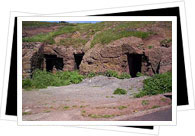
When Spanish conquistadores set foot on the Canary Islands, they found the Guanche population living essentially at, by European standards, was considered a primitive level. Wearing animal skins for clothing, using stone tools for hunting and living in caves, the islands were begging for a good Christianizing modernization- at least that's how the Europeans saw things!
Yet today, you'll still see inhabited cave homes throughout the paradisaical archipelago. Even after the revolutionizing Spanish conquest, caves continued to be a significant part of the islands' architectural heritage. Today you can find these traditional cave homes throughout the Canary Islands, although they've naturally been updated to include modern amenities- just imagine a cave with an internet connection and cable television! The greatest number of villages composed almost exclusively of cave homes is located in Gran Canaria, Tenerife's eastern neighbor.
The excavation of cave homes into the mountain side is yet another still-existing remnant of the indigenous Canarian population, a culture that understood how to benefit from the natural landscape. How did they go about making a typical Canarian cave home? Traditionally, it began first with the excavation of a simple rectangle. However, as time went on the cave began expanding to include bedrooms, kitchens and sometimes even a workshop. In front of the home, you'll almost always find a gardened patio which, aside from the obvious aesthetic benefits, help to keep the cave home cool and ventilated.